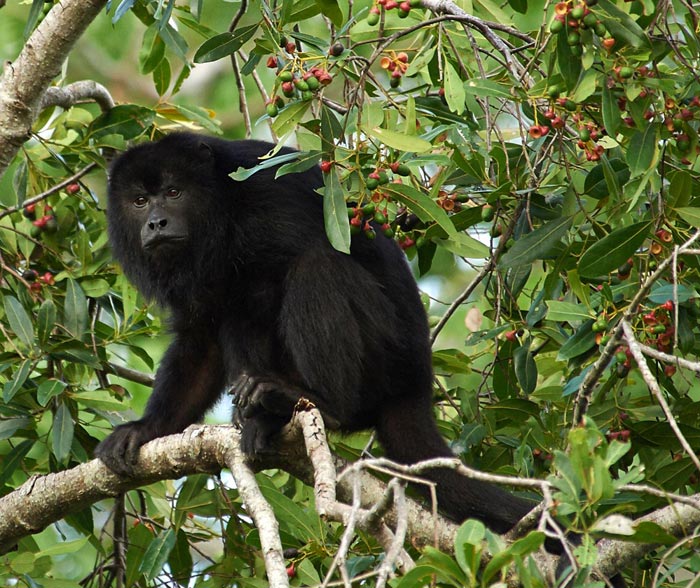

In some areas of Costa Rica, howler monkeys like this one are infected with parasites once limited to capuchin and spider monkeys. After humans hunted capuchins and spider monkeys out of existence in the region, the parasites immediately switched to howler monkeys, where they persist today.
Photo courtesy Daniel Brooks Photography
The appearance of infectious diseases in new places and new hosts, such as West Nile virus and Ebola, is a predictable result of climate change, says a noted zoologist affiliated with the Harold W. Manter Laboratory of Parasitology at the University of Nebraska-Lincoln.
In an article published online today in conjunction with a special issue of the Philosophical Transactions of the Royal Society B, Daniel Brooks warns that humans can expect more such illnesses to emerge in the future, as climate change shifts habitats and brings wildlife, crops, livestock, and humans into contact with pathogens to which they are susceptible but to which they have never been exposed before.
“It's not that there's going to be one 'Andromeda Strain' that will wipe everybody out on the planet,” Brooks said, referring to the 1971 science fiction film about a deadly pathogen. “There are going to be a lot of localized outbreaks putting pressure on medical and veterinary health systems. It will be the death of a thousand cuts.”
Brooks and his co-author, Eric Hoberg, a zoologist with the U.S. National Parasite Collection of the USDA's Agricultural Research Service, have personally observed how climate change has affected very different ecosystems. During his career, Brooks has focused primarily on parasites in the tropics, while Hoberg has worked primarily in Arctic regions.
Each has observed the arrival of species that hadn't previously lived in that area and the departure of others, Brooks said.
“Over the last 30 years, the places we've been working have been heavily impacted by climate change,” Brooks said in an interview last week. “Even though I was in the tropics and he was in the Arctic, we could see something was happening.” Changes in habitat mean animals are exposed to new parasites and pathogens.
For example, Brooks said, after humans hunted capuchin and spider monkeys out of existence in some regions of Costa Rica, their parasites immediately switched to howler monkeys, where they persist today. Some lungworms in recent years have moved northward and shifted hosts from caribou to muskoxen in the Canadian Arctic.
But for more than 100 years, scientists have assumed parasites don't quickly jump from one species to another because of the way parasites and hosts co-evolve.
Brooks calls it the “parasite paradox.” Over time, hosts and pathogens become more tightly adapted to one another. According to previous theories, this should make emerging diseases rare, because they have to wait for the right random mutation to occur.
However, such jumps happen more quickly than anticipated. Even pathogens that are highly adapted to one host are able to shift to new ones under the right circumstances.
Brooks and Hoberg call for a “fundamental conceptual shift” recognizing that pathogens retain ancestral genetic capabilities allowing them to acquire new hosts quickly.
“Even though a parasite might have a very specialized relationship with one particular host in one particular place, there are other hosts that may be as susceptible,” Brooks said.
In fact, the new hosts are more susceptible to infection and get sicker from it, Brooks said, because they haven't yet developed resistance.
Though resistance can evolve fairly rapidly, this only changes the emergent pathogen from an acute to a chronic disease problem, Brooks adds.
“West Nile Virus is a good example – no longer an acute problem for humans or wildlife in North America, it nonetheless is hhere to stay,” he said.
The answer, Brooks said, is for greater collaboration between the public and veterinary health communities and the “museum” community – the biologists who study and classify life forms and how they evolve.
In addition to treating human cases of an emerging disease and developing a vaccine for it, he said, scientists need to learn which non-human species carry the pathogen.
Knowing the geographic distribution and the behavior of the non-human reservoirs of the pathogen could lead to public health strategies based on reducing risk of infection by minimizing human contact with infected animals, much likethose that reduced the incidence of malaria and yellow fever by reducing human contact with mosquitos.
Museum scientists versed in understanding the evolutionary relationships among species could use this knowledge to anticipate the risk of the pathogen becoming established outside of its native range.
Brooks, who earned his bachelor's and master's degrees from the University of Nebraska-Lincoln, was a zoology professor at the University of Toronto for 30 years until he retired early in 2011 to devote more time to his study of emerging infectious disease. In addition to being a senior research fellow with UNL's Manter Laboratory, he is a visiting senior fellow at the Universidade Federal do Parana, Brazil, funded by the Ciencias sem Fronteiras (Sciences without Borders) of the Brazilian government, and a visiting scholar with Debrecen University in Hungary.
Brooks' and Hoberg's article, “Evolution in action: climate change, biodiversity dynamics and emerging infectious disease,” is part of a Philosophical Transactions of the Royal Society B issue on “Climate change and vector-borne diseases of humans,” edited by Paul Parham, a specialist in infectious disease epidemiology at Imperial College in London.
“We have to admit we're not winning the war against emerging diseases,” Brooks said. “We're not anticipating them. We're not paying attention to their basic biology, where they might come from and the potential for new pathogens to be introduced.”












